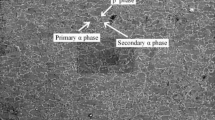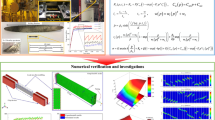Abstract
To predict the residual stress distribution of the Ti-4Al-1.5Mn (TC2) alloy in the manufacturing process, quickly and accurately, a precise dynamic constitutive model for rheological behavior and a new simplified approach for numerical simulation were proposed. The dynamic stress-strain curves indicate that the enhancement effect and plasticizing of the TC2 alloy are sensitive to high strain rates. The dispersed β particles play an important role in the formation of the adiabatic shear band and not widened significantly. The average relative error of 1.04% and the correlation coefficient of 0.9949 indicate that the modified Johnson-Cook constitutive model well describes the rheological behavior. Then, with the help of the Almen test, an efficient but simplified approach was proposed to achieving coverage and uniform loading in simulation. At last, the residual stress contribution of the TC2 alloy in the shot peening test is in a good agreement with the simulation results by random multipellet model.


















Similar content being viewed by others
References
Jiang ZD (2013) Study on microstructure and properties of CO2 laser welding butt weld joints of TC2 titanium alloy sheets. Electric Welding Machine 43:80–82. https://doi.org/10.7512/j.issn.1001-2303.2013.08.19
Zong YY, Shao B, Wang XG, Guo B, Shan DB. (2018) Effect of hydrogen on phase transformation, thermal deformation behavior, and forming limit of TC2 alloy. Adv Eng Mater, 20. https://doi.org/10.1002/adem.201800690
Li Y, Pei Z, Zaman B, Zhang Y, Yuan H, Cao B. (2018) Effects of plastic deformations on the electrochemical and stress corrosion cracking behaviors of TC2 titanium alloy in simulated seawater. Materials Research Express, 5. https://doi.org/10.1088/2053-1591/aadc44
Harrison J (1987) Controlled shot peening: cold working to improve fatigue strength. Heat Treat 19:16–18
Ghorashi MS, Farrahi GH, Movahhedy MR (2019) Effect of severe shot peening on the fatigue life of the laser-cladded Inconel 718 specimens. Int J Adv Manuf Technol 104(5–8):2619–2631. https://doi.org/10.1007/s00170-019-04082-6
Torres M, Voorwald H (2002) An evaluation of shot peening, residual stress and stress relaxation on the fatigue life of AISI 4340 steel. Int J Fatigue 24:877–886. https://doi.org/10.1016/S0142-1123(01)00205-5
Meguid SA (1991) Effect of partial-coverage upon the fatigue fracture behaviour of peened components. Fatigue Fract Eng Mater Struct 14:515–530. https://doi.org/10.1111/j.1460-2695.1991.tb00680.x
Zimmermann M, Klemenz M, Schulze V (2010) Literature review on shot peening simulation. Int J Comput Mater Sci Surf Eng 3:289. https://doi.org/10.1504/IJCMSSE.2010.036218
Silva DP, Bastos IN, Fonseca MC (2020) Influence of surface quality on residual stress of API 5L X80 steel submitted to static load and its prediction by artificial neural networks. Int J Adv Manuf Technol 108(11–12):3753–3764. https://doi.org/10.1007/s00170-020-05621-2
Wang C, Wang C, Wang L, Lai Y, Li K, Zhou Y (2020) A dislocation density-based comparative study of grain refinement, residual stresses, and surface roughness induced by shot peening and surface mechanical attrition treatment. Int J Adv Manuf Technol 108(1–2):505–525. https://doi.org/10.1007/s00170-020-05413-8
Elmagd E, Abouridouane M (2006) Characterization, modelling and simulation of deformation and fracture behaviour of the light-weight wrought alloys under high strain rate loading. Int J Impact Eng 32:741–758. https://doi.org/10.1016/j.ijimpeng.2005.03.008
Ali T, Wang L, Cheng X, Liu A, Xu X (2019) Omega phase formation and deformation mechanism in heat treated Ti-5553 alloy under high strain rate compression. Mater Lett 236:163–166. https://doi.org/10.1016/j.matlet.2018.10.057
Yi XB, Zhang JX, Li BD, Guo XR, Li XF, Chang WC. (2019) Dynamic compressive mechanical properties of TB6 titanium alloy under high temperature and high strain rate. Rare Metal Materials and Engineering, 48:1220–1224. WOS: 000467321400030
Skubisz P, Lisiecki L, Packo M, Skowronek T, Micek P, Tokarski T. (2018) Effect of high strain rate beta processing on microstructure and mechanical properties of near- titanium alloy Ti-10V-2Fe-3Al. Proceedings of the Institution of Mechanical Engineers Part L—Journal of Materials-Design and Applications, 232:181–190. https://doi.org/10.1177/1464420715619447
Brozek C, Sun F, Vermaut P, Millet Y, Lenain A, Embury D, Jacques PJ, Prima F (2016) A beta-titanium alloy with extra high strain-hardening rate: design and mechanical properties. Scr Mater 114:60–64. https://doi.org/10.1016/j.scriptamat.2015.11.020
Huang GQ, Xie LS, Chen MH, Si SS, Wu RH (2019) Flow stress characteristics and constitutive relation of Ti2AlNb alloy under high strain rate. Rare Metal Mater Eng 48:847–852 WOS: 000463845300023
Zheng Y, Zeng W, Wang Y, Zhou D, Gao X (2017) High strain rate compression behavior of a heavily stabilized beta titanium alloy: kink deformation and adiabatic shearing. J Alloys Compd 708:84–92. https://doi.org/10.1016/j.jallcom.2017.02.284
Steinberg DJ, Cochran SG, Guinan MW (1980) A constitutive model for metals applicable at high-strain rate. J Appl Phys 51:1498–1504. https://doi.org/10.1063/1.327799
Zerilli FJ, Armstrong RW (1987) Dislocation-mechanics-based constitutive relations for material dynamics calculations. J Appl Phys 61:1816–1825. https://doi.org/10.1063/1.338024
Cook GRJA (1985) Fracture characteristics of three metals subjected to various strains, strain rates, temperatures and pressures. Eng Fract Mech. https://doi.org/10.1016/0013-7944(85)90052-9
Bhalerao, Nitin B, Joshi, Suhas S, Naik et al (2018) High strain rate and high temperature behavior of Ti-6Al-4V alloy under compressive loading. J Eng Mater Technol 140. https://doi.org/10.1115/1.4038671
Che JT, Zhou TF, Liang ZQ, Wu JJ, Wang XB (2018) An integrated Johnson-Cook and Zerilli-Armstrong model for material flow behavior of Ti-6Al-4V at high strain rate and elevated temperature. J Braz Soc Mech Sci Eng 40. https://doi.org/10.1007/s40430-018-1168-7
Ara B, Ramin G, Mario G (2012) On the shot peening surface coverage and its assessment by means of finite element simulation: a critical review and some original development. Appl Surf Sci 259:186–194. https://doi.org/10.1016/j.apsusc.2012.07.017
Mohamed J, Augustin G, Julie L, Oussama et al (2016) Robust methodology to simulate real shot peening process using discrete-continuum coupling method. Int J Mech Sci 107:21–33. https://doi.org/10.1016/j.ijmecsci.2016.01.005
Kim T, Lee H, Kim M, Jung S (2012) A 3D FE model for evaluation of peening residual stress under angled multi-shot impacts. Surf Coat Technol 206:3981–3988. https://doi.org/10.1016/j.surfcoat.2012.03.078
Dassault Systèmes. Abaqus 6.12 online documentation. Providence, RI: Dassault Systèmes, 2012
Chen JS, Desai DA, Heyns SP, Pietra F (2019) Literature review of numerical simulation and optimisation of the shot peening process. Advances in. Mech Eng 11(3):168781401881827. https://doi.org/10.1177/1687814018818277
Elbella A, Rami V, Hogirala J. A sensitivity analysis of shot peening parameters. In: ASME 2006 International design engineering technical conferences & computers and information in engineering conference (IDETC/CIE), Philadelphia, PA, 10–13 September 2006. New York: ASME
Kim T, Jin HL, Lee H, Cheong SK (2010) An area-average approach to peening residual stress under multi-impacts using a three-dimensional symmetry-cell finite element model with plastic shots. Mater Des 31:50–59. https://doi.org/10.1016/j.matdes.2009.07.032
Farrahi GH, Lebrijn JL, Couratin D (2007) Effect of shot peening on residual stress and fatigue life of a spring steel. Fatigue Fract Eng Mater Struct 18:211–220. https://doi.org/10.1111/j.1460-2695.1995.tb00156.x
Curtis S, Rios ERDL, Rodopoulos CA, Levers A (2003) Analysis of the effects of controlled shot peening on fatigue damage of high strength aluminium alloys. Int J Fatigue 25:59–66. https://doi.org/10.1016/S0142-1123(02)00049-X
Tekeli S (2002) Enhancement of fatigue strength of SAE 9245 steel by shot peening. Mater Lett 57:604–608. https://doi.org/10.1016/S0167-577X(02)00838-8
Xiao X, Sun Y, Zhao R, Yang M, Gao G, Li Y (2019) A design for lumped mass of a shot model in random peening simulation and prediction of dimple size evolution. Int J Adv Manuf Technol 103(9–12):4597–4608. https://doi.org/10.1007/s00170-019-03581-w
Xiang J, Pang S, Xie L, Cheng G, Liang R, Gao F, Bai L (2018) A numerically low-cost and high-accuracy periodic FE modeling of shot-peened 34CrNiMo6 and experimental validation. Int J Adv Manuf Technol 97(5–8):1673–1685. https://doi.org/10.1007/s00170-018-2029-3
Gangaraj SMH, Guagliano M, Farrahi GH (2014) An approach to relate shot peening finite element simulation to the actual coverage. Surf Coat Technol 243:39–45. https://doi.org/10.1016/j.surfcoat.2012.03.057
Miao HY, Larose S, Perron C, Levesque M (2009) On the potential applications of a 3D random finite element model for the simulation of shot peening. Adv Eng Softw 40:1023–1038. https://doi.org/10.1016/j.advengsoft.2009.03.013
Majzoobi GH, Azizi R, Nia AA. (2005) A three-dimensional simulation of shot peening process using multiple shot impacts. Journal of Materials Processing Technology, 164–165:1226–1234. doi: https://doi.org/10.1016/j.jmatprotec.2005.02.139
Stranart SAMA (2002) 3D FE analysis of peening of strain-rate sensitive materials using multiple impingement model. Int J Impact Eng 27:119–134. https://doi.org/10.1016/s0734-743x(01)00043-4
Zhuo C, Fan Y, Meguid SA (2014) Realistic finite element simulations of arc-height development in shot-peened Almen strips. J Eng Mater Technol 136:41001–41002. https://doi.org/10.1115/1.4028006
Huang XF, Liu ZW, Xie HM (2013) Recent progress in residual stress measurement techniques. Acta Mechanica Solida Sinica 26:570–583 CNKI:SUN:GTLB.0.2013-06-002
Kim T, Lee H, Jung S, Jin HL (2012) A 3D FE model with plastic shot for evaluation of equi-biaxial peening residual stress due to multi-impacts. Surf Coat Technol 206:3125–3136. https://doi.org/10.1016/j.surfcoat.2011.12.042
Teo A, Ahluwalia K, Aramcharoen A (2020) Experimental investigation of shot peening: correlation of pressure and shot velocity to Almen intensity. Int J Adv Manuf Technol 106(11):4859–4868. https://doi.org/10.1007/s00170-020-04982-y
Li Y (2011) Shot stream finite element model for shot peening numerical simulation and its experiment study. J Mech Eng 47:43. https://doi.org/10.3901/JME.2011.22.043
Hu DY, Gao Y, Meng FC, Song J, Wang YF, Ren MX, Wang RQ (2017) A unifying approach in simulating the shot peening process using a 3D random representative volume finite element model. Chin J Aeronaut 030:1592–1602. https://doi.org/10.1016/j.cja.2016.11.005
Acknowledgments
The authors gratefully acknowledge the support from the Aeronautical Science Foundation of China (20153021001).
Author information
Authors and Affiliations
Corresponding author
Additional information
Publisher’s note
Springer Nature remains neutral with regard to jurisdictional claims in published maps and institutional affiliations.
Rights and permissions
About this article
Cite this article
Su, N., Chen, M., Xie, L. et al. Dynamic characterization of Ti-4Al-1.5Mn titanium alloy and a simplified approach for shot peening simulation. Int J Adv Manuf Technol 111, 2733–2747 (2020). https://doi.org/10.1007/s00170-020-06299-2
Received:
Accepted:
Published:
Issue Date:
DOI: https://doi.org/10.1007/s00170-020-06299-2




